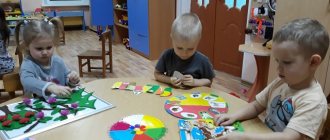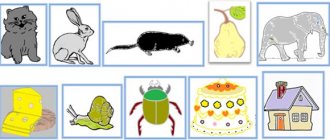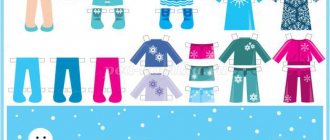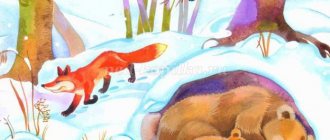Summary of an open lesson on sensory skills in the first junior group
Summary of an open lesson on the sensory development of children in the first junior group "Balapan" on the topic: "Visiting the sun."
Target:
To form children's understanding of color, size and shape.
Tasks
:
1. Exercise children in the relationship of objects by size. (big small).
2. Learn to use words denoting their quantity (one and many).
3. Strengthen the ability to group objects by color.
4. Strengthen the ability to name geometric shapes
5.Develop fine motor skills, logical thinking, attention.
6. Instill in children a sense of responsiveness and a desire to help.
Equipment and materials
: 2 baskets (large and small), carrots (large and small according to the number of children), baskets of 3 colors, mushrooms (the same color as the baskets), 3 houses with geometric shapes cut out in the middle (circle, square, triangle). Sunny, clothespins in two colors.
Polylingual component: bear - ayu, hare-koyan, red - kyzyl - red.
Progress of the lesson:
- Guys, look how many guests we have today! Let's greet them, say hello!
- Now let’s say to our hands: “Good morning hands! You woke up?" (we stroke).
Good morning little eyes! You woke up?
Good morning legs! You woke up?
We woke up, smiled,
Let's reach for the sun!
- Oh, guys, where is our sun? There is no sun, our sun was lost and for some reason it became so sad without him!
- Guys, I propose to go on an unusual journey, in search of the sun.
And what we will travel on, you have to guess.
Come to me, I will draw what we will move on, and you tell me what it is.
(I draw a balloon on the semolina with my finger), the children call it a balloon.
- And now each of you will draw a ball on which he will go on a journey.
(children draw balls). Let's inflate our balloons (breathing exercises).
I take out a ball with a long ribbon, hold on to the ribbon, we go on a journey. (Sharika's music sounds).
- Guys, here we are in a wonderful clearing! Look, who is meeting us?
- That's right, bunny.
Bunny, bunny, tell me! Bunny, show me bunny!
How can we find the sun? How can we get to the sun?
— Bunny
: I would be happy to help you, but Mother Hare gave me a job: I need to put the carrots in baskets. Large carrots in a large basket, and small carrots in a small one.
— Guys, can we help the bunny arrange the carrots? (children lay out carrots).
- We helped the bunny, well done guys! Now let's dance with the bunny.
(They dance to the music “gray bunny”). The bunny shows the way to the sun.
“Hold on to the ribbon, we’re moving on.”
- Look, who is meeting us?
- Children
: It's a hedgehog!
Hedgehog, hedgehog, tell me! Hedgehog, show me the hedgehog!
How can we find the sun? How can we get to the sun?
- Hedgehog
: I will definitely help, but the hedgehogs scattered the mushrooms and need to be collected in baskets.
— What color are the mushrooms? What color are the baskets? (red, blue, green).
- You need to arrange the mushrooms by color: (red ones - in a red basket, blue ones - in a blue one, green ones - in a green one).
(Children put mushrooms in baskets).
- Well done boys! Helped the hedgehog.
“Hold on to the ribbon, we’re moving on.”
- Guys, look, who is this on our way?
- Children
: This is Mishka.
- Bear
: I’m busy with a very interesting job, but it’s very complicated.
“I just can’t manage to arrange geometric shapes in my houses.”
- Guys, can we help Mishka arrange the pieces in their houses?
— What figures live in the first house? (circles).
- Which ones are in the second? (squares).
- What are in the third? (triangles)
I will give you one figurine, and you each put them in your house.
- Well done guys, you helped Mishka.
- And here is the house where the sun lives!
- Sun
: Oh, hello guys! Thank you for waking me up!
Sunny, why are you so sad?
- Sun
: Rays, my children got lost in the fields, scattered through the forests!
- Guys, look, what is the sun missing? (rays).
- What color are the rays of the sun? (yellow).
- Let's attach yellow rays to the sun.
— What color are the clothespins here? (yellow and blue).
- You and I will only take yellow clothespins and attach them to the sun.
- Well done guys, what a beautiful sun we have created!
- What geometric figure does it resemble? (per circle).
- What is it, big or small? (big)
- How many rays does the sun have? (a lot of).
- The sun needs a lot of rays to warm us all, that’s how good it is!
- Guys, tell the sun, who helped us find him? (hedgehog, bunny, bear)
- How did we help the hedgehog, the bunny and the bear?
- The sun wants to thank each of you for your help, but for this we need to return to the group.
- Hold on to the ribbon, we're coming back. (to the music we return to the group).
- Well, we have returned from our trip.
— Did you enjoy the trip? You were great today, and the sun gave you a beautiful box, let's open it and see what's in it?
(I open a box of sweets and treat the children).
Summary of an open lesson on the sensory development of children in the first junior group "Balapan" on the topic: "Visiting the sun."
Prepared by teacher: Raiskaya.N.N.
“Teddy bear in kindergarten”: final lesson on sensory skills
- February 9, 2014
Competition “My Pedagogical Initiative - 2013”
Nomination “Methodological work in preschool educational institutions”
In their centuries-old practice, people have created certain standards of shapes, sizes, and color tones. The child needs to master these standards and receive, as it were, a set of standards with which he can compare any newly perceived property of an object and give it a proper definition.
In life, a child encounters a variety of shapes, colors and other properties of objects. It is still very difficult for him to understand all this diversity, and he needs the help of adults. The teacher organizes the child’s sensory experience using a certain social experience. The accumulation of sensory representations involves familiarization with color, shape, and size.
Educational areas: Cognition, communication, socialization.
Types of children's activities: speech, play, motor.
Program content:
- continue to teach children logical thinking using the siriation method (correct assembly of the pyramid);
- find a pair based on two characteristics (large - small and color);
- consolidate knowledge of colors (red, blue, yellow, green);
- Strengthen children's knowledge about wild animals (bear);
- cultivate a friendly attitude between peers, a desire to help each other;
- consolidate children's knowledge about parts of their body.
Goal : to consolidate children’s knowledge of color, shape, size.
Equipment : teddy bear, pyramid, ball, basket with mushrooms, cut-out pictures, dishes.
Participants : children of the 1st junior group, teacher.
Progress of the lesson
Children enter the group and see pyramid rings scattered on the floor.
Educator: Ay - ah - ah, who scattered the toys?
A teddy bear sits on a chair.
Educator: Bear, were you the one who scattered the toys around the group?
Bear: Yes, I came to visit you and played a little.
Educator: Guys, is it possible to behave like this when visiting? (Children's answers).
Bear: forgive me, I won’t do that again.
Educator: Bear, since you understand that this is bad, then assemble a pyramid, and the guys will help you, you just need to assemble it correctly, first the large rings, then the smaller ones.
Children collect rings throughout the group. The teacher holds a rod on which rings are strung. As the pyramid is collected, the teacher specifies the color, size and shape of the ring. When the pyramid is assembled, the teacher praises the children. Mishka thanks the children for their help and invites them to play the game “Let’s get to know each other.” The children stand in a circle, Mishka throws the ball to them in turn, and the children say their name.
Bear: I slept in my den all winter, and spring came, I woke up and decided to come to visit you and play. Do you know where I live?
Children: In the forest!
Bear: That's right, do you know who else lives in the forest? (Children's answers). My friend Squirrel gave you gifts from her supplies, look, what are they?
Shows the children a basket of mushrooms. The bear randomly scatters mushrooms on the floor.
Bear: Oh, guys, can you help me collect mushrooms?
Children: Yes!
Children collect mushrooms, the teacher specifies what they are (what color, size, hard or soft).
Educator: Guys, let's also give Mishka a gift, we'll treat him with delicious and sweet berries.
The didactic game “Cut Pictures” is being played.
Bear: Thank you guys, you are so good!
The teacher invites the children to recite A. Barto’s poem “Bear”.
Bear: Oh, guys, show me where my paw is? Eyes? Ears? Nose?
Educator: Mishka, don’t you know the parts of your body at all? The guys and I will help you!
A physical session “Studying our body” is being held:
One, two, three, four, five - let's study the body! Here is the back, and here is the tummy, arms, legs, eyes, nose, mouth, ears, head - I barely managed to shake it. Neck - turns her head, oh, tired oh - oh - oh! The forehead and eyebrows, and the eyelashes, fluttered like birds. Pink cheeks, bumpy chin. The hair is thick, like meadow grass. Shoulders, elbows and knees. With me, Seryozha, Lena!
Bear: Thank you guys, you taught me a lot today.
Educator: Children, what did we teach Mishka today? (Children's answers).
The teacher invites the children to treat Mishka to tea, but the cups on the table are mixed up. I will give you saucers, and you match them with cups of the same color and size.
The didactic game “Find a Pair” is being played.
Children treat the bear with tea.
List of sources used:
Wenger L.A., Pilyugina E.G., Wenger N.B. Nurturing a child’s sensory culture.
Author: Evgenia Mikhailovna Vedrentseva, teacher of the Suzun kindergarten No. 2, working village of Suzun, Novosibirsk region. Teaching experience 2 years.



